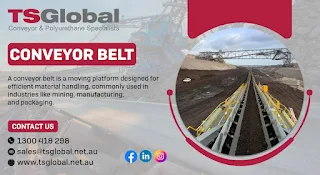When it comes to reliable and efficient conveyor solutions, businesses in Sydney trust a manufacturer that prioritizes quality and innovation. A well-designed conveyor system ensures smooth operations in industries such as mining, agriculture, manufacturing, and logistics. Key components like conveyor belt scrapers, conveyor impact beds, and pulley lagging play a crucial role in maintaining efficiency and reducing downtime. If you are looking for the best conveyor belt solutions, you need a manufacturer with a proven track record in delivering high-performance products tailored to your needs.
Enhancing Performance with Conveyor Belt Scrapers
One of the biggest challenges in conveyor operations is material buildup on belts, which can lead to inefficiencies and costly maintenance. Conveyor belt scraper are essential for removing excess material from the belt, ensuring a cleaner and more efficient system. High-quality scrapers help prevent material spillage, reduce wear and tear on belts, and extend their lifespan. Investing in a reliable scraper means fewer interruptions and increased productivity for your operation.
Importance of Conveyor Belt Cleaning
Effective conveyor belt cleaning is crucial for maintaining operational efficiency and preventing premature belt damage. Regular cleaning prevents material carryback, reduces maintenance costs, and enhances workplace safety. A trusted pulley manufacturer in Sydney provides innovative cleaning solutions tailored to various industries, ensuring that your conveyor system remains in peak condition. Proper belt cleaning also helps maintain product quality by minimizing contamination, especially in food processing and pharmaceutical industries.
Protecting Your System with Conveyor Impact Beds
Conveyor impact beds are designed to absorb the impact of heavy materials being loaded onto the belt, reducing damage and extending the belt’s lifespan. These beds are strategically placed at loading zones to minimize belt sagging and improve material transfer. A well-engineered impact bed helps prevent belt misalignment and reduces the risk of costly breakdowns. By choosing a reputable manufacturer in Sydney, businesses can ensure that their conveyor systems are built to withstand demanding industrial environments.
High-Quality Conveyor Belts for Every Industry
A conveyor belt is the backbone of any material handling system, facilitating the movement of goods with minimal manual effort. Different industries require specific belt types to handle varying loads, speeds, and environmental conditions. Whether you need heat-resistant, oil-resistant, or abrasion-resistant belts, selecting the right manufacturer ensures you get a product that meets your operational demands. Partnering with an expert conveyor belt provider guarantees superior quality, durability, and long-term cost savings.
The Role of Pulley Lagging in Conveyor Efficiency
Pulley lagging is a critical component that enhances the performance of conveyor pulleys by increasing friction between the belt and the pulley surface. This reduces slippage, improves traction, and extends the life of both the belt and the pulley. Quality lagging materials such as rubber, ceramic, or polyurethane provide additional protection against wear and corrosion. By incorporating high-performance pulley lagging into your conveyor system, you can achieve improved efficiency, reduced maintenance, and enhanced safety.
Choosing the Right Manufacturer in Sydney
Selecting a trusted pulley manufacturer in Sydney is key to ensuring the longevity and efficiency of your conveyor system. Here are some factors to consider when choosing a manufacturer:
Industry Experience: Look for a company with a strong reputation and years of expertise in conveyor system solutions.
Quality Materials: Ensure that the manufacturer uses high-quality materials to produce durable and efficient conveyor components.
Customization Options: A good manufacturer offers customized solutions tailored to your specific industry needs.
Customer Support: Reliable after-sales support, including maintenance services and technical assistance, is essential for long-term success.
Competitive Pricing: While quality should never be compromised, a trusted manufacturer provides cost-effective solutions without sacrificing performance.
Conclusion
Investing in high-quality conveyor components such as conveyor belt, conveyor impact beds, conveyor belt cleaning systems, and pulley lagging is essential for maintaining an efficient and reliable conveyor system. Whether you operate in mining, manufacturing, or food processing, choosing Sydney’s trusted pulley manufacturer ensures durability, efficiency, and long-term savings. Upgrade your conveyor system today with premium solutions designed to optimize performance and reduce maintenance costs.


.jpg)


